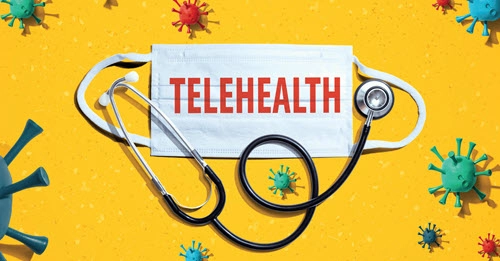Expect More Telehealth Claims Scrutiny in 2021
Tip: Keep concise documentation in case of an audit. Over the past year, organizations have grappled with an endless pandemic, which has crippled healthcare infrastructures, upended avenues for patient-provider interactions, and caused general pandemonium. However, there’s been one saving grace that has kept many practices afloat during these trying times — the Medicare telehealth services expansion. Background: A public health emergency (PHE) declaration by the Department of Health and Human Services (HHS) Secretary allows for regulatory leniency and relaxed federal guidelines. During the COVID-19 PHE, the feds have issued a bevy of 1135 waivers and other flexibilities — including expanding telehealth services offerings — that have made it easier for providers to connect with their patients virtually and still get paid. With social distancing and lockdowns still in place across the nation and the PHE expected to stretch on for the remainder of the year, experts anticipate that providers’ reliance on telehealth services — and the waivers and flexibilities associated with the PHE — will only increase (see box, p. 3). Caveat: Though the feds have removed some regulatory roadblocks, they’ve also made a plethora of changes and updates often to the telehealth services rules that have caused both provider consternation and billing mishaps. Some practices aren’t following the specifics of the regulations, says Terry Fletcher, BS, CPC, CCC, CEMC, CCS, CCS-P, CMC, CMCSC, CMCS, ACS-CA, SCP-CA, owner of Terry Fletcher Consulting Inc. and consultant, auditor, educator, author, and podcaster at Code Cast in Laguna Niguel, California. There’s a 60 to 70 percent error rate on telehealth service claims, Fletcher says, and points to the distinction between audio versus audio and video as a major problem area. Many evaluation and management (E/M) services are being furnished via telephone, yet providers are submitting claims saying that they’re administered via audio and video interactions. Auditors are even confirming with patients that their interactions occurred without video engagement, with the patients verifying that they didn’t even have any video capability at that time, Fletcher notes. Also practices need to be careful about which staff members are making phone calls and interacting with patients over the phone or other technology, according to your claims, Fletcher recommends. CMS has a list of approved providers and staff like registered nurses probably don’t make the cut. Remember: Telehealth refers to health services that include audio and video components. If you’re uncertain about which services CMS (and most other commercial carriers) allow to be conducted via audio-only interactions, you can check current guidance. CMS has a list of which E/M codes can be furnished via telehealth versus audio-only services, both during the PHE and generally. See the current list at www.cms.gov/Medicare/Medicare-General-Information/Telehealth/Telehealth-Codes. Both HHS and CMS have recently updated their telehealth services guidance. Find the COVID-19 Frequently Asked Questions (FAQs) on Medicare Fee-for-Service (FFS) Billing at www.cms.gov/files/document/medicare-telehealth-frequently-asked-questions-faqs-31720.pdf and the HHS’ patient and provider assistance, facilitated in coordination with the Health Resources & Services Administration (HRSA), at www.telehealth.hhs.gov. OIG Targets Telehealth Services in Recent Work Plan Updates In addition to trying to cut down their error rate in the middle of a pandemic, providers now have another reason to tighten up their telehealth claims. The HHS Office of Inspector General (OIG) added telehealth services used during the COVID-19 PHE to its audit agenda. Details: On Jan. 26, OIG added home healthcare provided as telehealth services during the PHE to the Work Plan Active Item list. Under the telehealth expansion, “CMS amended regulations to allow home health agencies to use telecommunications systems in conjunction with in-person visits,” the Active Item announcement says. And now, the feds want “to determine which types of skilled services were furnished via telehealth, and whether those services were administered and billed in accordance with Medicare requirements,” says the Active Item brief. “We will report as overpayments any services that were improperly billed. We will make appropriate recommendations to CMS based on the results of our review,” OIG indicates. Part B: “Concurrent with the HHA telehealth announcement, the OIG also announced the addition of another telehealth-related audit and evaluation project to be added to the current OIG Work Plan,” note attorneys Matthew Shatzkes and John Tilton with law firm Sheppard, Mullin, Richter & Hampton LLP in online legal analysis. The feds also plan to audit Part B telehealth services utilized during the COVID-19 PHE, notes a separate Work Plan announcement. Due to its importance during the pandemic, the watchdog agency intends to “conduct a series of audits” through a two-phase approach, the OIG brief indicates. The first audit phase will investigate whether Medicare telehealth requirements were followed for E/M visits, “opioid use order, end-stage renal disease, and psychotherapy,” OIG explains. “Phase two audits will include additional audits of Medicare Part B telehealth services related to distant and originating site locations, virtual check-in services, electronic visits, remote patient monitoring, use of telehealth technology, and annual wellness visits to determine whether Medicare requirements are met,” the Active Item materials add. Bottom line: “There are still plenty of options and solutions available to Medicare providers that wish to safeguard themselves against the potential downside of future telehealth audit and oversight activity by the OIG,” say Shatzkes and Tilton. “A robust regulatory compliance program that includes telehealth as an audit priority is one such option,” they add. Resource: See the Work Plan and other recently added Action Items at https://oig.hhs.gov/reports-and-publications/workplan/active-item-table.asp. Bank on PHE to Last All Year If you’re worried that the flexibilities associated with the COVID-19 public health emergency (PHE) will be going away soon, think again. The PHE is expected to extend through 2021, according to a new Department of Health and Human Services (HHS) letter to state governors. Backtrack: Before resigning last month, outgoing HHS Secretary Alex Azar extended the PHE for a fourth time for another 90 days, effective Jan. 21. Azar previously extended the PHE in April, July, and October. Now: With the pandemic not going away any time soon, the Biden Administration anticipates waivers and regulatory relief to last all year. “To assure you of our commitment to the ongoing response, we have determined that the PHE will likely remain in place for the entirety of 2021,” HHS Acting Secretary Norris Cochran said in the Jan. 22 letter. “When a decision is made to terminate the declaration or let it expire, HHS will provide states with 60 days’ notice prior to termination.” The letter specifically mentions telemedicine as a tool to increase access to healthcare during a PHE. “Predictability and stability are important given the foundation and flexibilities … that are tied to the designation of the PHE,” Cochran maintains.


